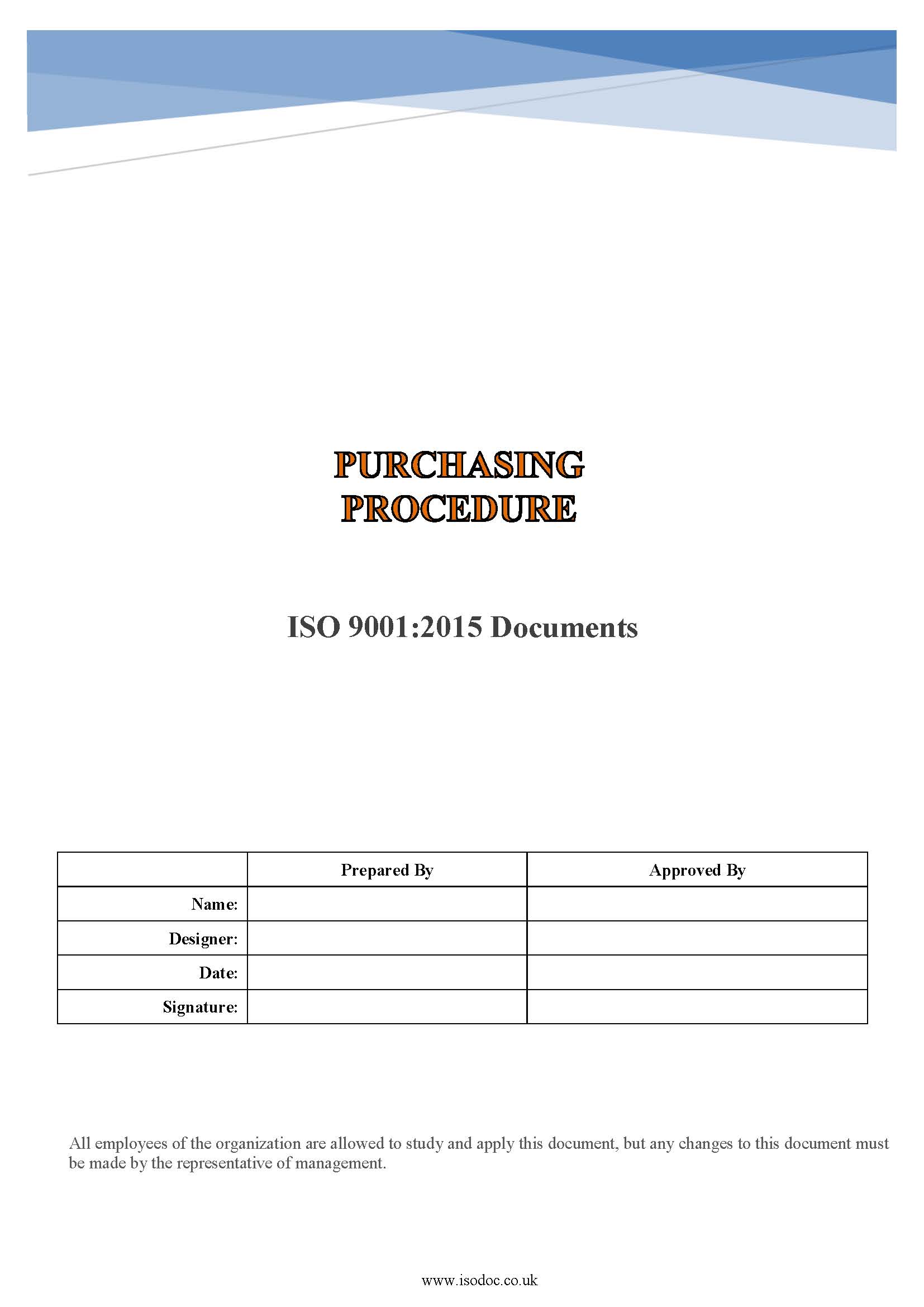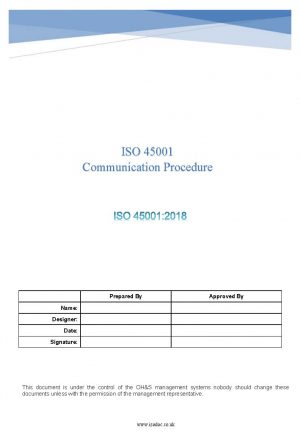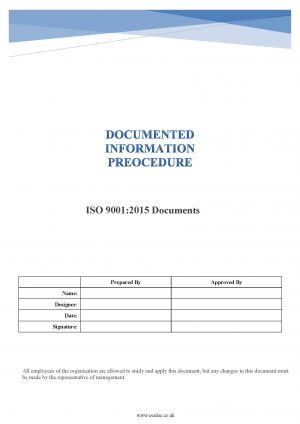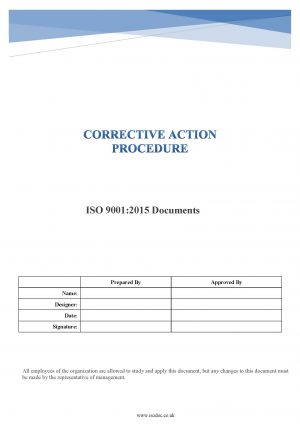Description
Implementation of the Procurement Procedure in ISO 9001-Compliant Quality Management Systems
1. What Is a Purchasing Procedure?
A purchasing procedure is a documented guideline that defines the process for procuring goods and services. It outlines the key steps involved in purchasing, including roles and responsibilities, purchase scheduling, supplier evaluation, and the inspection and control of procured items or services.
Table of Contents
-
The Strategic Importance of Procurement in Modern Organizations
-
Step-by-Step Execution of the Procurement Procedure in ISO 9001
-
Download a Sample Procurement Procedure Template Based on ISO 9001
2. Is a Purchasing Procedure Mandatory?
Although ISO 9001 does not explicitly mandate the establishment of a formal procurement procedure, the provision of resources is a critical requirement for ensuring compliance with the quality management system. As such, the development and implementation of a structured purchasing procedure is strongly recommended.
Organizations that have adopted ISO 9001 standards are expected to define their procurement methods clearly and maintain appropriate records to demonstrate effective control and traceability of purchased products and services.
Procurement and purchasing procedures may vary significantly among organizations, each potentially designing its own mechanisms to meet operational and strategic needs. However, due to the critical role of procurement in organizational success, ISO 9001 establishes a general framework of requirements for standardizing and improving this process. This article outlines those key elements and explains how to align your procurement function with ISO 9001 standards.
3. What Is Procurement in a Business Context?
Before delving into the operational procedure of purchasing and procurement, it is important to define procurement from a business and process-oriented perspective. Procurement is a formalized process by which individuals and organizations acquire ownership of tangible or intangible assets—such as physical goods, digital services, or intellectual property—by exchanging them for a predetermined monetary value.
Procurement is not merely a transaction; it is a strategic process that typically begins with a recognized need, followed by supplier identification, negotiations, purchasing, and performance monitoring. Despite variations in execution, procurement systems across organizations share core elements such as requisitioning, supplier vetting, contract management, and quality assurance.
4. Why Organizations Need a Structured Procurement System
An effective procurement management system ensures that all purchasing activities are conducted in alignment with internal needs and organizational goals. A structured process helps reduce errors, control costs, and maintain compliance with both internal and external standards.
Every organization may tailor its procurement procedure to reflect its scale, complexity, industry regulations, and supplier landscape. Nevertheless, adopting an ISO 9001-based procurement system offers a proven framework for consistency, transparency, and continual improvement.
5. Overview of the ISO 9001 Quality Management System
ISO 9001 is the world’s most recognized quality management standard. It provides a systematic approach to managing processes that affect product and service quality. The standard is built around principles such as customer focus, leadership, process approach, and continual improvement.
Among its various clauses, ISO 9001 emphasizes the importance of externally provided processes, products, and services, which directly links to the procurement and supplier management functions.
6. The Strategic Importance of Procurement in Modern Organizations
Procurement is not just an operational necessity; it is a key driver of business performance. The quality of procured goods and services directly impacts production efficiency, cost-effectiveness, customer satisfaction, and regulatory compliance.
Optimizing the procurement process—especially by aligning it with a recognized standard like ISO 9001—can lead to reduced risk, improved quality, and increased responsiveness to market changes.
7. How Procurement Aligns with ISO 9001 Requirements
Under ISO 9001, procurement is a controlled process that must meet defined quality and compliance requirements. The standard mandates that organizations ensure suppliers are capable of consistently delivering products and services that meet contractual and regulatory requirements.
By integrating ISO 9001 principles into purchasing procedures, companies can benefit from structured supplier evaluations, ongoing performance reviews, and a data-driven improvement cycle.
8. Step-by-Step Execution of the Procurement Procedure in ISO 9001
Here is a breakdown of how procurement should be implemented in compliance with ISO 9001:
🔹 Planning and Strategy
Define procurement objectives, align purchasing plans with business goals, and determine criteria for supplier selection and contract terms.
🔹 Supplier Evaluation and Selection
Assess suppliers based on capability, compliance, past performance, and pricing. This step may involve supplier audits, reference checks, or pre-qualification assessments.
🔹 Supplier Communication and Coordination
Establish clear and consistent communication channels with suppliers. Transparency, collaboration, and timely information exchange are critical to procurement success.
🔹 Monitoring Supplier Performance
Evaluate ongoing supplier performance using key performance indicators (KPIs) such as delivery reliability, quality conformity, and responsiveness.
🔹 Quality Control of Procured Goods and Services
Apply inspection and verification methods to ensure purchased goods and services meet defined specifications. This includes sampling, testing, and documentation.
🔹 Optimization and Cost Efficiency
Analyze procurement data regularly to identify inefficiencies, reduce waste, and leverage economies of scale. Implement corrective actions and continuous improvement practices.
9. Conclusion and Benefits of Standardized Procurement
Implementing a standardized procurement procedure aligned with ISO 9001 empowers organizations to:
-
Increase the consistency and traceability of purchasing activities
-
Improve supplier accountability and performance
-
Reduce procurement risks and hidden costs
-
Enhance overall product and service quality
-
Improve customer satisfaction and competitiveness
By institutionalizing procurement within the ISO 9001 framework, organizations build a foundation for sustainable success and regulatory compliance.
10. Download the ISO 9001 Procurement Procedure Sample
Click below to download a professionally structured procurement procedure template aligned with ISO 9001:2015 requirements. This sample illustrates how to document, control, and implement an effective purchasing process in compliance with quality system standards.
📥 [Download Sample Procurement Procedure – ISO 9001 Format]

What does this procedure include?
This procedure includes the text of the procedure and the purchase order form.
ISO 9001 – Purchasing Clause
8.4 Control of externally provided processes, products, and services
8.4.1 General
The organization shall ensure that externally provided processes, products, and services conform to requirements.
The organization shall determine the controls to be applied to externally provided processes, products and services when:
a) Products and services from external providers are intended for incorporation into the organization’s own products and services;
b) products and services are provided directly to the customer(s) by external providers on behalf of the organization;
c) a process, or part of a process is provided by an external provider as a result of a decision by the organization.
Supplier evaluation procedure
The organization shall determine and apply criteria for the evaluation, selection, monitoring of performance, and re-evaluation of external providers, based on their ability to provide processes or products and services in accordance with requirements. The organization shall retain documented information of these activities and any necessary actions arising from the evaluations.
According to this clause, the organization shall develop a Supplier evaluation procedure that explains the steps of the supplier evaluation process.
8.4.2 Type and extent of control
The organization shall ensure that externally provided processes, products, and services do not adversely affect the organization’s ability to consistently deliver conforming products and services to its customers.
The organization shall:
a) ensure that externally provided processes remain within the control of its quality management system;
b) define both the controls that it intends to apply to an external provider and those it intends to apply to the resulting output;
c) take into consideration:
1) the potential impact of the externally provided processes, products and services on the organization’s ability to consistently meet customer and applicable statutory and regulatory requirements;
2) the effectiveness of the controls applied by the external provider;
d) determine the verification, or other activities, necessary to ensure that the externally provided
processes, products, and services meet requirements.
8.4.3 Information for external providers
The organization shall ensure the adequacy of requirements prior to their communication to the external provider.
The organization shall communicate to external providers its requirements for:
a) the processes, products, and services to be provided; b) the approval of:
1) products and services;
2) methods, processes, and equipment;
3) the release of products and services;
c) competence, including any required qualification of persons;
d) the external providers’ interactions with the organization;
e) control and monitoring of the external providers’ performance to be applied by the organization;
f) verification or validation activities that the organization, or its customer, intends to perform at the external providers’ premises.






Reviews
There are no reviews yet.